Your cart is currently empty!
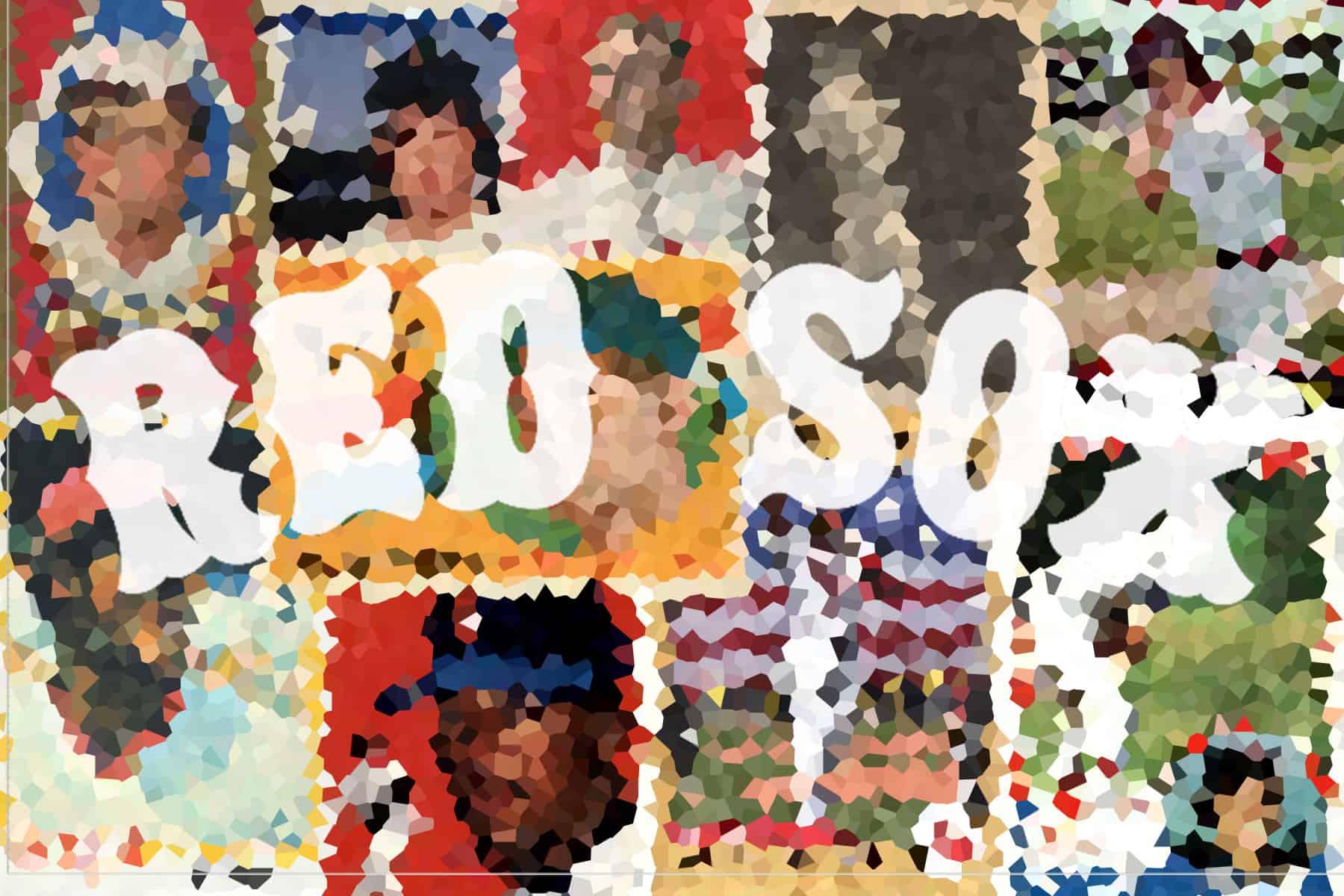
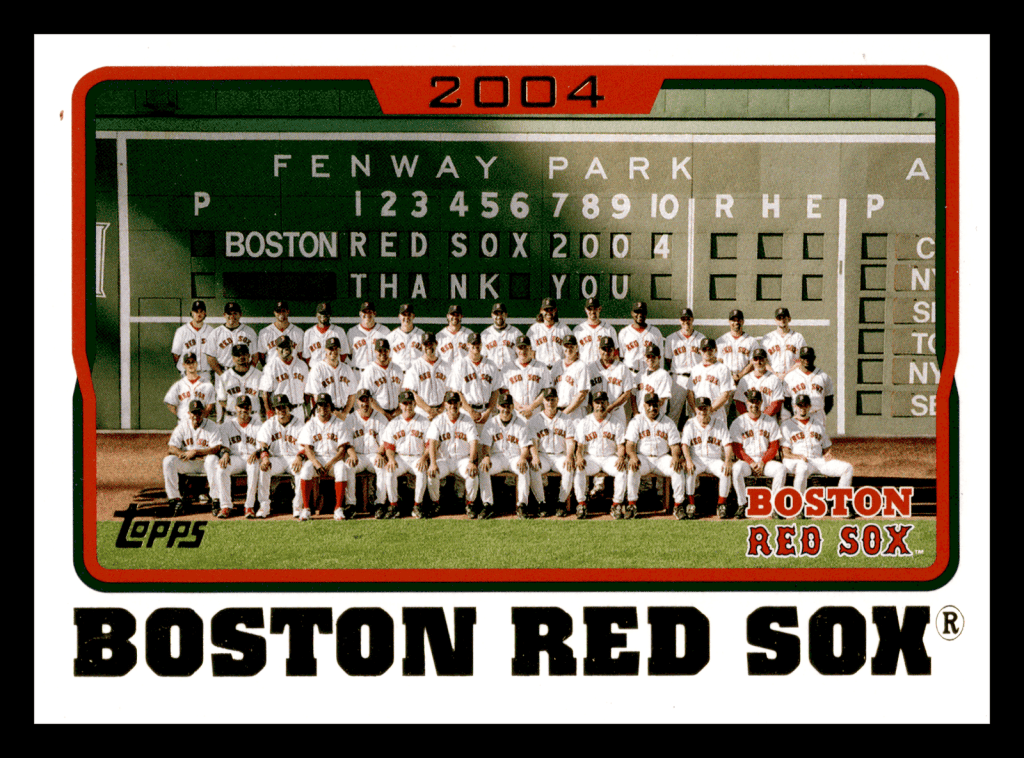
The Boston Red Sox boast a legacy that spans well over a century. Established in 1901, the team has undergone various incarnations and relocations – From its initial inception as the Boston Americans to the iconic Red Sox (and Red Sox baseball cards) we recognize today. The franchise is characterized by its passionate fan base, historic ballparks, and a championship pedigree that has both thrilled and agonized supporters over the years.
In its nascent years, the team found its home in the Huntington Avenue Grounds. They played as the Boston Americans until 1908. Subsequently, a pivotal moment in the franchise’s history occurred with the construction of Fenway Park in 1912. This iconic ballpark, nestled in the heart of Boston, has become synonymous with the Red Sox. It remains one of the oldest and most beloved stadiums in all of baseball.
The Red Sox’s championship legacy began to take shape in the early 20th century. Notably, the team clinched its inaugural World Series title in 1903, followed by titles in 1912, 1915, 1916 and 1918.
Who knows how many more they’d have won if not for the Curse of the Bambino? The curse originated from the controversial sale of Babe Ruth to the New York Yankees in 1919. This was an ill-fated decision that haunted the Red Sox for 86 years. Despite numerous close calls and tantalizing moments, the elusive championship remained just out of reach. This fueled the mystique surrounding the curse. The anguish of near misses became an integral part of the team’s narrative, intensifying the emotional connection between the Red Sox and their fervent supporters.
The narrative of heartbreak, however, underwent a transformative shift in 2004. In a historic comeback, the Red Sox triumphed over the Yankees in the American League Championship Series. They exorcized the ghosts of the past and paved the way for an emphatic World Series victory. This watershed moment, often referred to as the “Reverse the Curse” campaign, shattered the near-century’s long championship drought. It also solidified the Red Sox as a resilient and triumphant force in baseball history.
Building on this momentum, the Red Sox secured additional championships in 2007 and 2013. They’re now perennial contenders. The team’s success in the 21st century stands as a testament to the enduring spirit of the franchise and its ability to overcome adversity.
10. Dwight Evans
Player History
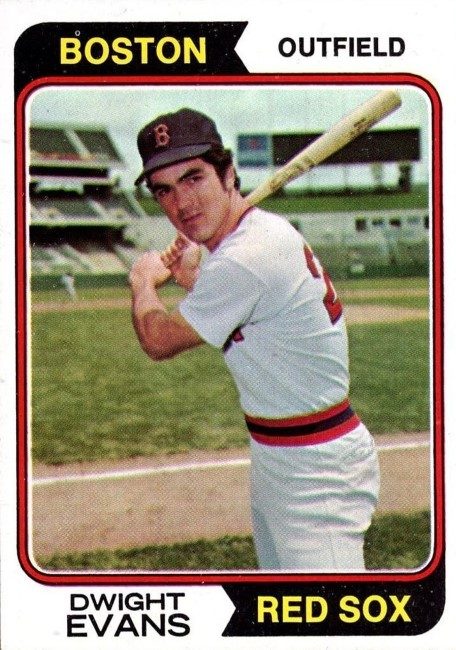
Dwight Evans, a stalwart in the outfield for the Boston Red Sox, enjoyed a prolific career spanning 19 seasons. The majority of his career was spent donning the iconic Red Sox uniform. Debuting in 1972, Evans quickly established himself as a defensive maestro and a potent offensive force. Renowned for his powerful arm, he recorded one of the highest outfield assist totals in the history of the game. His tenure with the Red Sox saw him contributing significantly to their successes, most notably the 1975 World Series run.
Evans’ offensive prowess was equally impressive. He proved to be a consistent run producer by massing 2,373 hits and 385 home runs during his Red Sox career. His keen eye at the plate resulted in numerous walks, contributing to an impressive on-base percentage. Evans is also one of only 34 players all-time with at least 1,300 runs scored, 1,300 RBIs, and 1,300 walks. Accolades for Evans include eight Gold Glove Awards, three All-Star selections, and two Silver Slugger Awards.
Dwight Evans was a key figure in the Red Sox’s playoff appearances during the late 1970s and early 1980s. His leadership and offensive contributions playing a crucial role. His impact on the Red Sox organization is epitomized by his inclusion in the team’s Hall of Fame.
Dwight Evans is not in the National Baseball Hall of Fame, although his worthiness is hotly debated by baseball fans. He is one of the most accomplished players – by WAR, OPS and other measurements – who is not in the Hall of Fame.
Best Red Sox card: 1974 Topps Dwight Evans #351
Evans’s rookie card came out in 1973, but it was shared with Al Bumbry and Charlie Spikes. His first solo card is the 1974 Topps. The coloring and the pose make it a favorite among Red Sox fans. The design has plenty of light if you want an autographed version. The card is easily found and tops out around $100 for the highest grades. It has an average price in the $10-$20 range.
9. Jim Rice
Player History
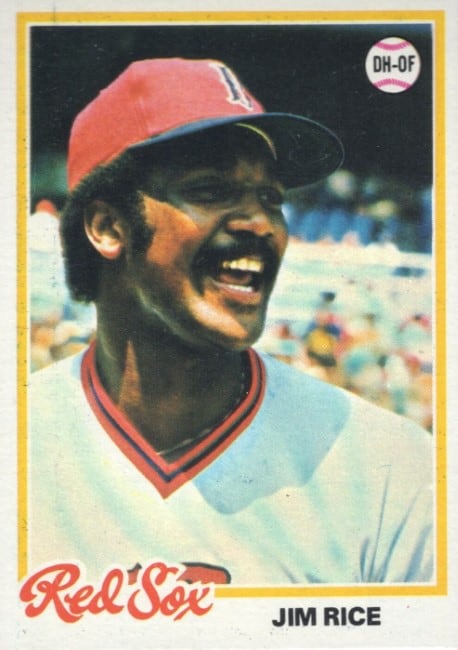
Debuting in 1974, Jim Rice quickly became one of the most feared power hitters in the game and in the Red Sox lineup. His offensive prowess was on full display throughout his 16 seasons with the Red Sox. He consistently ranked among the league leaders in home runs, RBIs, and batting average.
Rice’s crowning achievement came in 1978 when he was named the American League MVP. That season, he led the league in home runs (46), RBIs (139), and slugging percentage. In the process, he solidified his status as one of the premier sluggers of his era. He finished in the top 5 of MVP voting a further five times in his career.
His impact on the Red Sox’s lineup was profound. He played a pivotal role in leading the team to two AL pennants in 1975 and 1986, although World Series victories eluded them. Accolades for Rice include eight All-Star selections and two Silver Slugger Awards.
Rice is also remembered for his quick action on August 7, 1982. During the game, a foul ball struck a child in the stands. Rice ran behind the dugout and carried the boy into the clubhouse, where he received prompt medical attention. According to Rice, he did what any father would do. However, the incident showed the country a sensitive side to the mighty slugger.
Jim Rice entered the Hall of Fame in 2009 after 15 years on the ballot.
Best Red Sox card: 1978 Topps Jim Rice #670
Like many cards in the 70s, Jim Rice’s rookie card is a quad-design. It features three other players alongside this future Hall of Famer. Since we like to honor solo appearances, Rice’s best card is the 1978 Topps from his MVP season. It’s a simple card, but Rice is smiling and the style is perfect for the time period. Mint versions sell in the $30-$50, and expect to pay closer to $100 for a PSA 9.
8. Tris Speaker
Player History
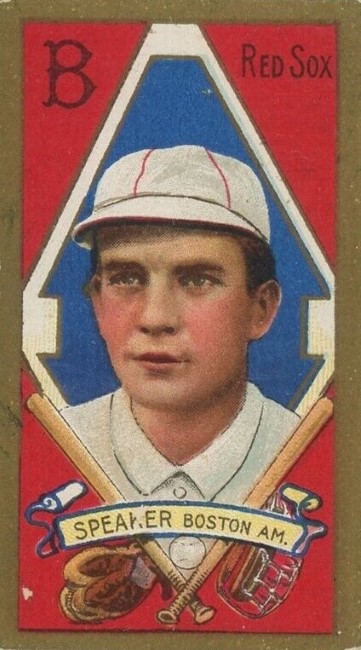
Tris Speaker left an indelible mark on the Boston Red Sox during his tenure from 1907 to 1915. Renowned for his exceptional hitting and defensive skills, Speaker played a pivotal role in the success of the Red Sox during the “Dead Ball Era.” As the team’s center fielder, he exhibited outstanding range and a strong arm as one of the era’s premier outfielders. It was said that when he played right field, it was “where triples go to die.”
Speaker’s offensive contributions were equally impressive. He consistently batted over .300 and was a key contributor to the Red Sox’s World Series triumph in 1912. His leadership and hitting prowess were integral to the team’s success during that championship season. Speaker’s impact on the Red Sox laid the foundation for a remarkable career that would see him become one of baseball’s all-time greats. Among all players, he is 6th all-time in batting average, 5th in hits and 1st in doubles. Accolades for Speaker include three World Series championships with the Red Sox and an AL MVP award in 1912.
Following a pay dispute in 1915, Boston traded Speaker to Cleveland. It was known as the franchise’s worth trade of all-time. (Eventually, the trade of Babe Ruth to the Yankees surpassed it.) Speaker continued on his legendary path in Cleveland. He earned induction into the National Baseball Hall of Fame in 1937.
Best Red Sox card: 1911 T205 Gold Border Tris Speaker
The T206 Tris Speaker would be an obvious mention here, because it’s one of his most recognizable and most valuable. But we chose the 1911 T205 Gold Border (and you could easily substitute its near-twin, the 1912 T202 Hassan Triple Folder with Speaker and Smoky Joe Wood).
This card is one of the brightest and most interesting of the time period. It shows Tris Speaker against a bright red diamond-shaped background. If you want to honor his teammate and near-Hall of Famer, Joe Wood – pick up the Triple Folder instead. Both are available in the $1,000-$3,000 range for cards in good condition.
7. Cy Young
Player History
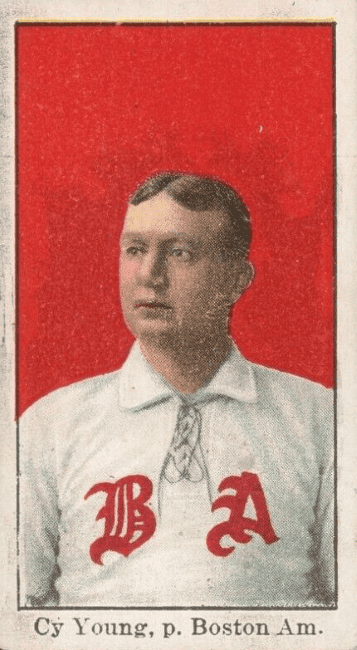
When you think about pitching excellence, you hear the name “Cy Young.” Young had a seven year career with the Red Sox from 1901 to 1908. A formidable pitcher, he played a pivotal role in the early success of the franchise. His impressive career included a multitude of achievements. Most notably, he threw the first pitch in American League history on April 24, 1901.
Young’s statistical dominance is exemplified by his numerous records that remain unmatched to this day. Notably, he secured 192 victories during his time with the Red Sox. This was a testament to his exceptional durability and effectiveness on the mound. His accomplishments include winning the pitching Triple Crown in 1901, leading the league in wins, strikeouts, and ERA. Young’s incredible durability is highlighted by his record-setting 511 career complete games. It’s a feat unlikely to be replicated in today’s era of specialized pitching roles.
Though World Series championships eluded Young during his Red Sox years, his impact on the team and the sport’s history is immortalized in the prestigious Cy Young Award, an annual honor presented to the best pitcher in each league. The enduring significance of the Cy Young Award stands as a fitting tribute to a player who not only dominated his era but also set a standard for excellence that transcends time. Young’s contributions to the Red Sox laid a foundation for the team’s future success.
Cy Young entered the Hall of Fame, class of 1937, alongside teammate Tris Speaker.
Best Red Sox (Americans) card: 1909 E90-1 American Caramel Cy Young
Many of Young’s most famous cards were issued while he was with Cleveland. Finding a good Boston card is more difficult. The E90-1 cards came as giveaways with caramels. Young has both a Boston and Cleveland version, but it’s the Boston one we love. The card features a bright red background and a “BA” (Boston Americans) on his chest. The card sells in poor condition (PSA 1 or PSA 2) for between $3,000-$6,000.
6. David Ortiz
Player History
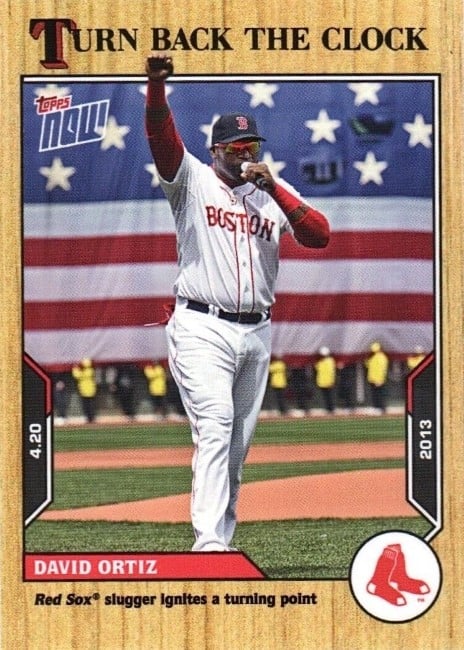
David Ortiz, affectionately known as “Big Papi,” is one of the Red Sox’s most iconic figures. Ortiz’s tenure with the Red Sox spanned from 2003 to 2016. During that time, he became the face of the team and a symbol of clutch hitting in the postseason. A designated hitter and occasional first baseman, Ortiz was revered for his leadership, charisma, and philanthropy.
Ortiz’s tenure with the Red Sox coincided with a transformative period for the franchise. In 2004, he played a pivotal role in the team’s historic comeback in the ALCS against the Yankees. His heroics continued in the World Series, where he delivered key hits, earning him MVP honors for the series. This championship marked the beginning of a new era for the Red Sox. He won two additional World Series titles in 2007 and 2013.
Throughout his illustrious career with the Red Sox, Ortiz consistently displayed remarkable power at the plate. His ability to deliver in clutch situations, often characterized by game-winning home runs, earned him the reputation of being one of the most clutch hitters in baseball history. Ortiz was a ten-time All-Star during his Red Sox tenure, and he accumulated numerous accolades, including seven Silver Slugger Awards. He had 483 career home runs with the Red Sox, second all-time for the team.
In 2016, Ortiz bid farewell to his playing career, culminating a remarkable chapter in Red Sox history. He earned induction into the Baseball Hall of Fame in 2022.
Best Red Sox card: 2021 Topps Now David Ortiz Turn Back the Clock #20
David Ortiz’s career began in Minnesota as “David Arias.” His first Red Sox baseball cards weren’t issued until six years later, in 2003. Where he truly endeared himself to his city, however, was with his 2013 speech at Fenway Park after the Boston Marathon bombing that killed three people and injured nearly 300 more. Ortiz got on the mic and roared, “This is our f*ing city!” This card celebrates that bellwether moment. The card is $5-$10 in ungraded condition, but the meaning behind it is worth so much more.
5. Pedro Martinez
Player History
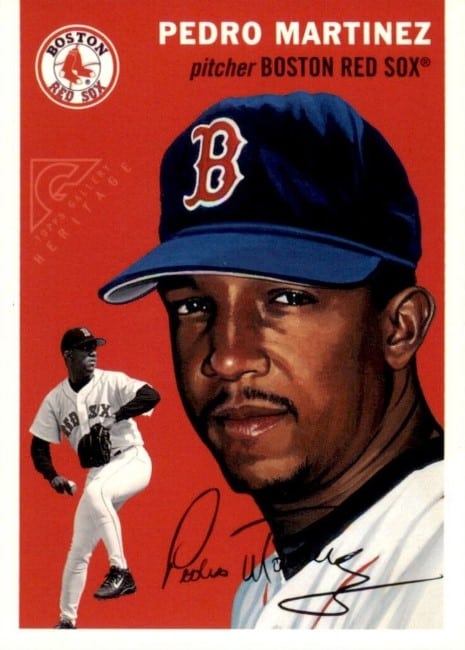
Pedro Martinez was a diminutive but electrifying right-handed pitcher for Boston from 1998 to 2004. Martinez’s time with the Red Sox is synonymous with dominance, precision, and an unrivaled competitive spirit. His arrival in Boston marked a turning point for the franchise, as Martinez played a pivotal role in transforming the team into a perennial contender.
Martinez’s statistical achievements with the Red Sox are nothing short of remarkable. A two-time Cy Young Award winner during his seven-season tenure in Boston, he consistently led the league in strikeouts and ERA. In his 1999 season, he secured the pitching Triple Crown by leading the league in wins, strikeouts, and ERA. Martinez’s mesmerizing pitching arsenal, featuring a devastating changeup and pinpoint control, made him an intimidating force for opposing hitters.
The apex of Martinez’s Red Sox career culminated in the 2004 postseason, where he played a pivotal role in leading the team to its first World Series championship in 86 years. His performance in the American League Championship Series against the New York Yankees is the stuff of baseball legend. Despite battling injuries, Martinez displayed sheer determination, pitching with grit and delivering key victories that propelled the Red Sox to an unforgettable comeback. His contributions in the postseason further solidified his status as one of the greatest postseason pitchers in Red Sox history.
Martinez earned induction into the Baseball Hall of Fame in 2015.
Best Red Sox card: 2000 Topps Gallery Heritage Pedro Martinez #TGH11
Pedro Martinez pitched for the Dodgers and Expos at the beginning of his career, so his baseball card history with the Red Sox begins in 1998. His first Sox card is the 1998 Topps #338 Pedro Martinez, which is a beautiful card in its own right. But his best card is the 2000 Topps Gallery Heritage #TGH11. These glossy cards are predecessors of the Topps Heritage line of cards, and feature each player’s portrait on the front alongside a smaller action shot, and then a retro cartoon and stats on the back. The Martinez card looks amazing and costs around $5.
4. Wade Boggs
Player History
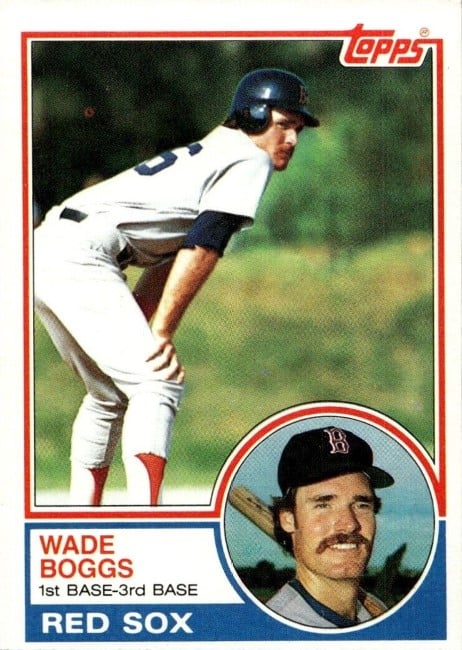
Wade Boggs had an unforgettable tenure with the Red Sox from 1982 to 1992. Renowned for his exceptional hitting prowess and consistency at the plate, Boggs became a symbol of offensive excellence in the heart of the Red Sox lineup. A left-handed hitting third baseman, Boggs showcased a keen eye for the strike zone and an ability to spray line drives to all fields, earning him a place among the game’s all-time great hitters.
Boggs had a string of impressive statistical achievements with the Red Sox. He won five batting titles during his time in Boston, a testament to his remarkable ability to make contact and hit for a high average. Boggs’s offensive contributions extended beyond just hitting for average; he displayed an exceptional ability to get on base, leading the league in on-base percentage six times with the Red Sox, and he finished in the top 10 of MVP voting four times.
Boggs was well-known for rigidness in his routines and has become famous for eating chicken before games. Whether or not this legend is strictly true, Boggs has been a good sport about it when the ritual became a subject of fascination and amusement among fans, teammates, and even opponents.
Wade Boggs entered the Baseball Hall of Fame in 2005.
Best Red Sox card: 1983 Topps Wade Boggs #498 (RC)
There’s a 2022 Stadium Club card featuring Boggs in a chicken coop, but we’ll let that one go in favor of his rookie card – the 1983 Topps #498. This is one of the most desired rookie cards from the 80s, with its classic design and coloring. Fleer and Donruss also issued Red Sox baseball cards for Boggs in 1983 but they aren’t nearly as coveted. Prices for the 1983 Topps card vary widely, but expect to pay between $1,000-$2,000 for a PSA 9 or PSA 10, all the way down to $20 for an ungraded card in excellent condition.
3. Roger Clemens
Player History
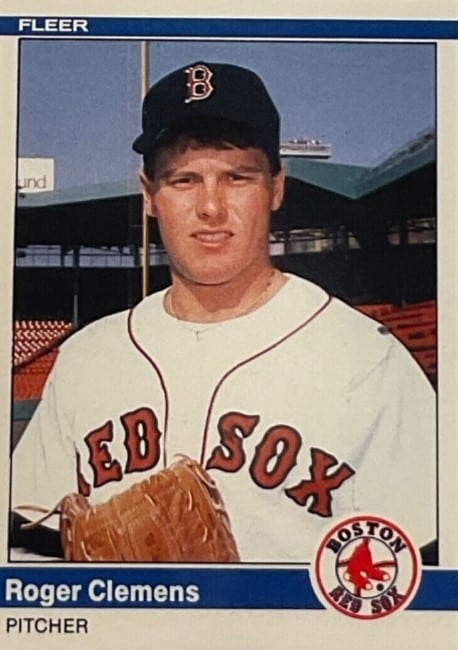
Roger Clemens, nicknamed “The Rocket,” established himself as one of the most dominant pitchers in baseball during his tenure with the Boston Red Sox from 1984 to 1996. A hard-throwing right-hander, Clemens’ overpowering fastball and tenacious approach on the mound made him a force to be reckoned with.
His illustrious career with the Red Sox included three Cy Young Awards and five All-Star selections. He finished in the top 3 of Cy Young voting twice more, and was also a top-3 MVP vote getter in 1990.
Clemens burst onto the scene with the Red Sox, winning the American League MVP and Cy Young Award in 1986 after a stellar season where he recorded 24 wins and struck out a staggering 238 batters. His dominance continued over the years, with Clemens leading the league in strikeouts three times with the Red Sox and in 1990, he became the first pitcher to strike out 20 batters in a nine-inning game. Clemens’ on-field success translated to team achievements, as he played a pivotal role in guiding the Red Sox to two American League pennants during his tenure.
While Clemens left an indelible mark on the Red Sox with his on-field exploits, his legacy is also marred by controversy. In the latter part of his career, Clemens faced allegations of using performance-enhancing drugs (PEDs), specifically in connection to the infamous Mitchell Report in 2007. This cloud of suspicion has blocked Clemens from entering the Baseball Hall of Fame. This was despite his remarkable achievements on the field. The PED scandal has cast a shadow over what would have otherwise been a clear-cut Hall of Fame career, leaving fans and baseball historians to grapple with the complex legacy of “The Rocket.”
Best Red Sox card: 1984 Fleer Update Roger Clemens #U27 (RC)
The 1984 Fleer Update set WAS Roger Clemens’s first Red Sox baseball card appearance. (Kirby Puckett was another prominent rookie that year.) These cards were distributed only as a complete set. Ungraded versions of Clemens’s rookie card run in the $150-$300 range, with graded versions costing up to $500-$1,500.
2. Carl Yastrzemski
Player History
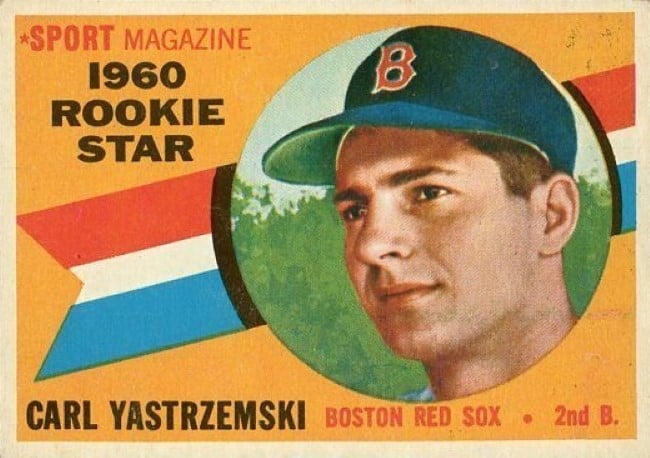
Carl Yastrzemski, affectionately known as “Yaz,” had an incredible career that spanned 23 seasons, from 1961 to 1983, playing entirely in Boston. Yastrzemski built his legacy with the Red Sox through his consistency, longevity, and leadership.
A left-handed-hitting outfielder, Yaz’s career is a testament to his unwavering dedication to the game and the franchise. His most iconic season came in 1967, a year often referred to as the “Impossible Dream” season for the Red Sox. Yaz led the league in batting average, home runs, and runs batted in (RBIs), capturing the Triple Crown—an extraordinary feat. His remarkable performance carried the Red Sox to the American League pennant and earned him both the American League Most Valuable Player (MVP) award and the Hickok Belt as the top professional athlete of the year. The Red Sox ultimately fell to the St. Louis Cardinals in a hard-fought seven-game World Series, but that didn’t dim Yastrzemski’s contributions.
Over the course of his career, Yastrzemski earned 18 All-Star selections and seven Gold Glove Awards. His remarkable durability shone through in his consecutive games played streak. He reached 1,120 games—a testament to his commitment to the game. He also won three batting titles.
Carl Yastrzemski was known for his quiet, stoic demeanor, often characterized by his reserved and focused nature. He was a man of few words, preferring to let his performance on the field speak for itself. Yastrzemski entered the Baseball Hall of Fame in 1989.
Best Red Sox card: 1960 Topps Carl Yastrzemski “Rookie Star” #148 (RC)
For many, the orange, horizontal design of Yastrzemski’s rookie card is etched in their minds. Topps gave him his own card two years before he appeared in the big leagues; that’s commonplace now, but virtually unheard of back then. And isn’t it cool when they get it right and a guy really does turn into a “Rookie Star?” The photo from this card was ultimately borrowed for his 1961 Topps, albeit with a different design. However, it’s the 1960 Topps that’s the true rookie. The card is pricey – approximately $2,000-$4,000 for a PSA 8 or PSA 9 – but in very good condition without professional grading costs around $200-$300.
1. Ted Williams
Player History
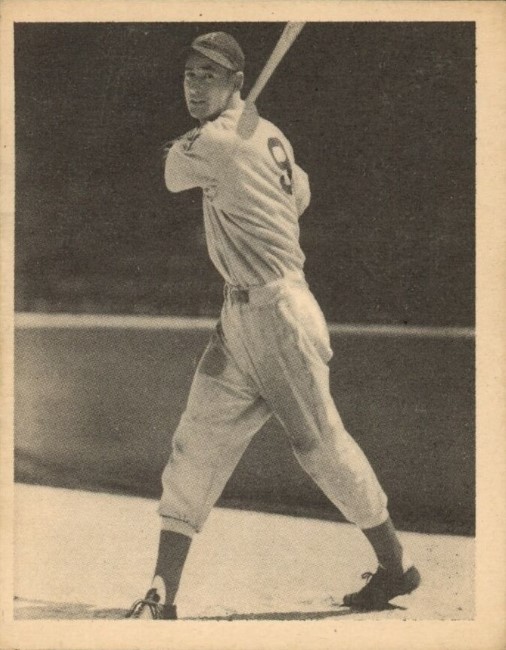
Ted Williams, often referred to as “The Splendid Splinter,” is widely regarded as one of the greatest hitters in the history of baseball. Spending his entire career with the Boston Red Sox from 1939 to 1960, Williams’s impact on the game and the franchise is nothing short of legendary. Williams was a left-handed hitter with an unmatched eye for the strike zone. Extraordinary offensive statistics and an unwavering commitment to excellence at the plate defined his success.
Williams had an amazing career batting average of .344. He earned six AL batting titles through his remarkable consistency and ability to get on base. In 1941, Williams achieved a feat that remains unparalleled in modern baseball history—he finished the season with a .406 batting average, becoming the last player to surpass the .400 mark. Beyond his batting accomplishments, Williams showcased power with 521 career home runs and an impressive on-base percentage that places him among the all-time greats.
His two American League MVP awards and an astonishing 19 All-Star selections further underscore Ted Williams’s offensive excellence.
Remarkably, Williams’ career could have been even better. Like many of his contemporaries, he didn’t play from 1943-1945 and instead enlisted in the military, achieving the rank of second lieutenant as a naval aviator in the Marine Corps. When he returned from war for the 1946 season at the age of 27, Williams picked up right where he’d left off, hitting 38 home runs, 128 RBI and batting .342. He also led the league in runs, walks, OBP, OPS, Slugging, total bases and intentional walks that season and received his first MVP award.
Like many Red Sox suffering under the Curse of the Bambino, Ted Williams never won a World Series, but that didn’t stop him from becoming the great Red Sox player of all-time. Williams entered the Baseball Hall of Fame in 1966.
Best Red Sox card: 1939 Play Ball Ted Williams #92 (RC)
This card is part of a seminal set beloved by collectors, and also the rookie card of one of baseball’s best players. The photography on the card is excellent quality and you can’t fault this card for much of anything except its price: one PSA 9 card sold for $480,000. Because condition is such a factor, you can get a PSA 3 or PSA for around $4,000.
Tags:
Share:
